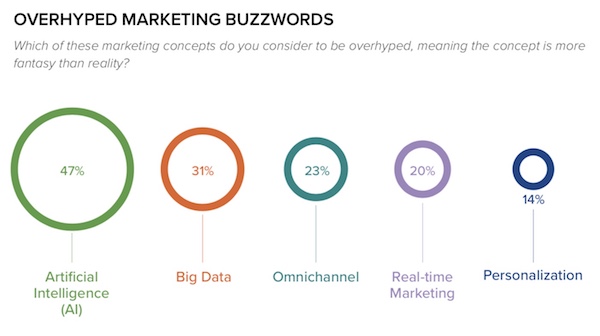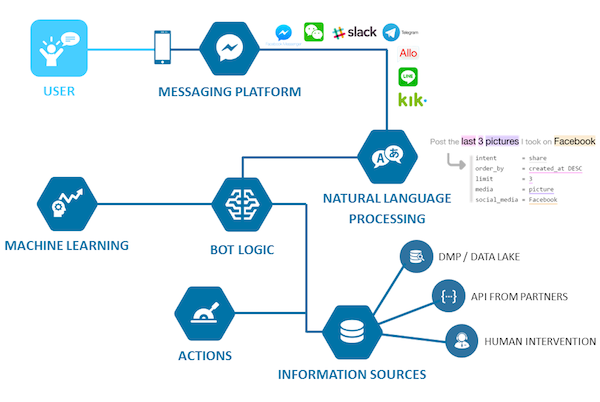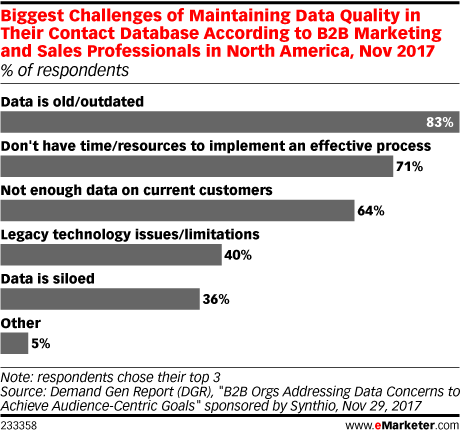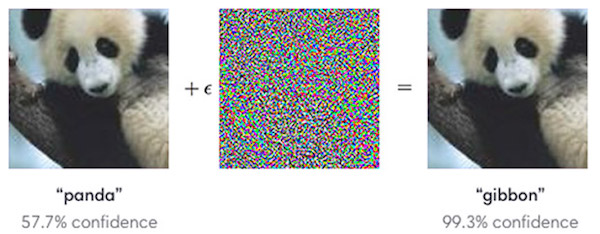Whew! This is the final part 5 of a five-part series, providing an update on the 5 Disruptions to Marketing as 2018 marches forward. If you have not yet read Part 1: Digital Transformation, Part 2: Microservices & APIs, Part 3: Vertical Competition, or Part 4: Digital Everything, you might want to start there.
5. ARTIFICIAL INTELLIGENCE (2018 Update)
A recent study by Resulticks found artificial intelligence to be the most over-hyped term in marketing today. And that was with stiff competition from the buzzword bingo of big data, omnichannel, real-time marketing, and personalization.
(You just know there’s a company somewhere promoting “omnichannel, real-time marketing personalization using big data and AI.”)
So it’s easy to be skeptical of the term. In Gartner’s hype curve, I think AI in marketing is already starting to peak, with disillusionment arriving quickly. I actually believe that, in general, the frequency of Gartner hype curves are increasing — you can go from the peak of hype to the trough of disillusionment within a year. But that’s an article for another time.
But as I wrote earlier this year, the one thing that everybody forgets about Gartner’s hype curve is that, even with the wildly swinging ups-and-downs of hype, the underlying technology continues to advance.
AI is not going to do your marketing for you. (And thank goodness, or you’d be out of a job.) There is no Alexa-voiced oracle that will magically reveal to you the right marketing strategy. The vision of a “general intelligence” AI that acts as a sentient being with a big brain is still a thing of science-fiction. In fact, it’s arguable if it could ever exist, as reasoned eloquently by François Chollet:
“There is no such thing as ‘general’ intelligence. On an abstract level, we know this for a fact via the ‘no free lunch’ theorem — stating that no problem-solving algorithm can outperform random chance across all possible problems. If intelligence is a problem-solving algorithm, then it can only be understood with respect to a specific problem. In a more concrete way, we can observe this empirically in that all intelligent systems we know are highly specialized. The intelligence of the AIs we build today is hyper-specialized in extremely narrow tasks — like playing Go, or classifying images into 10,000 known categories. The intelligence of an octopus is specialized in the problem of being an octopus. The intelligence of a human is specialized in the problem of being human.”
But here’s the irony: as much as the hype has overstated what AI might do for marketing in the next 12-24 months, the reality of how AI is already working in marketing today is often under-recognized.
One of my favorite articles from last year was Dave Chaffey’s and Robert Allen’s brilliant 15 Applications of Artificial Intelligence in Marketing article, listing a bunch of cases where “AI” already works, as shown in this graph:
Most of the use cases they describe are powered by one of three kinds of AI:
- Machine learning
- Propensity modeling
- Natural-language processing (NLP)
None of these are the kinds of AI supermachines you see romanticized in the movies.
They’re mostly statistical algorithms that find and match patterns and then extrapolate them to make predictions.
You know, auto-complete.
It’s math, not magic.
But that’s not a knock against these AI applications though. With today’s data volume and processing speed, these algorithms are highly effective at what they do. For instance, in lead scoring, machine learning and propensity modeling is beating humans and hard-wired, rules-based heuristics pretty regularly these days (here’s one case study that saw a 27% increase in sales as a result).
In a manner of speaking, machine learning is simply statistics at speed and scale. But that’s powerful. As Tomasz Tunguz, a venture capitalist at Redpoint Ventures (and one of our groovy speakers at the upcoming MarTech conference), recently wrote in an article on How To Identify A SaaS Market That Machine Learning Will Disrupt:
“By and large, the most frequent applications of machine learning in SaaS today are efficiency applications – automating the high-volume rote processes and reducing costs. Consequently, if you looking to build a machine learning based SaaS company, find a really expensive internal process and automate it.”
Similarly, natural-language processing (NLP) is undoubtedly cool — it powers the conversational interfaces of chatbots and voice-assistants — but it’s become relatively mundane software technology under the covers. Here’s a great visual from an article in Chatbots Magazine that explains the tech stack behind most “AI chatbots”:
The “natural-language processing” component and most of the algorithms applied in the “machine learning” piece are now at everyone’s disposal: built into messaging platforms, rentable in the cloud for pennies, or simply available as open source toolkits.
Where things get interesting with chatbots — their differentiation and competitive advantage — is in the “actions” and “information sources” pieces of the equation. What data and services are unique to your business? That’s where AI shines.
This can’t be overemphasized: good AI depends upon good data.
This is the single biggest challenge in AI applications in marketing today.
Unfortunately, data quality in most marketing systems still isn’t very good.
Just a couple of months ago, 83% of B2B marketers in a Demand Gen Report complained that their data is old and outdated.
And 71% don’t have time or resources to implement an effective process to improve their data quality — so it’s not getting any better for them any time soon. Feeding that bad data into a good machine learning algorithm won’t give the right answers. And without opening up the black box of the machine learning algorithm, you might not have any idea that those answers are wrong. Other than the poor outcomes you’re getting from it.
(It’s interesting to note that only 36% now report that their data is siloed. Linking back to Part 2: Microservices & APIs, systems are increasingly connected and sharing data. But if the data isn’t good, such easy integration is like sending your child to school with the flu — easy enough to put on the bus, but unfortunate for everyone else.)
Bad data in AI isn’t a problem limited to marketing either.
In fact, it can be helpful to read some of the latest writing from AI experts and data scientists about the flaws and risks of bad data — in some cases, intentionally bad data — acrosss the field more broadly.
The real danger of artificial intelligence — it’s not what you think is a particularly good, albeit disturbing, article on this topic. It explains how AI “can cause harm or discrimination” by:
- Using biased or poor quality data to train models
- Having poorly defined rules
- Using it out of context
- Creating feedback loops
Another article by Rhaul Bhargava, a research scientists at the MIT Media Lab, digs into this further with The Algorithms Aren’t Biased, We Are. He explains why, in machine learning, “the questions that matter are what is the textbook and who is the teacher” for the learning that the machine is doing.
An article in Scientific American, How to Hack an Intelligent Machine, describes how hackers can intentionally use bad data to “trick smart systems into making dumb gaffes.” Another article in IEEE Spectrum illustrates how Slight Street Sign Modifications Can Completely Fool Machine Learning Algorithms — and turn a panda into a gibbon:
One starts to realize that data quality and data security will both be intertwined challenges for marketers. Not just data security in the sense of preventing bad actors from stealing your data. But also data security in preventing bad actors from seeding bad data into your systems to knowingly mislead your machine learning marketing systems.
It’s all about the data.
Well, it’s mostly about the data. One other factor that we need to keep in mind with machine learning — and frankly, algorithmic marketing of any kind — is the exponentially accelerating speed at which these functions operate. It’s mind-bending.
As Alistair Croll recently wrote in It’s the Automation, “We conflate AI and automation at our peril. The power of automation isn’t the algorithm. It’s the relentless, parallel attention.” In talking about how an AI system learned to beat a popular chess software program in a matter of hours — and how — Alistair notes:
Don’t be surprised that an AI beat chess software. Be surprised that it played 1,228,800,000 games in 4 hours.
This completely changes the speed and scale of optimization and simulation applications.
For a real-world example in marketing, consider MarketBrew, an artificial intelligence platform for SEO teams. Normally, SEO professionals would make changes to a website and have to wait up to 60 days to see how those changes reflected rankings on Google.
MarketBrew’s AI engine, however, crawls the web on its own and creates a parallel “Google.” It uses machine learning to develop a fairly accurate model of how Google ranks sites. It can then constantly update this model to reflect changes in Google’s algorithms. As a result, an SEO professional can submit a proposed change to a website to MarketBrew, which is able to give a predicted answer on the impact it will have on rankings within 90 minutes. That’s impressive.
Yet still, the model is not reality. Just a good approximation of it.
Ultimately, this is why there is so much excitement around AI-and-human partnerships. Humans working in tandem with AI algorithms often produce better outcomes than either one on their own. Here’s just one example from an Accenture Fjord report about the accuracy of cancer detection by machines, humans, or the two together:
Humans bring context and “common sense” that still elude machine learning algorithms. On the other hand, AI brings greater mathematical accuracy and expontential computational horsepower to bear on problems than our own minds can offer.
Together, human and machine are powerful collaborators. One of the biggest disruptions to marketing over the next several years will be learning how to manage those collaborations to their fullest potential.
P.S. Want to hear a discussion of all 5 of these disruptions to marketing? Catch my webinar this Thursday at 1pm ET (or at least register to be able to watch it later):












I see everyone is writing about microservice and api, but i guess there will be a big time with AR and VR as well.
Great article. AI is very important in content creation marketing.